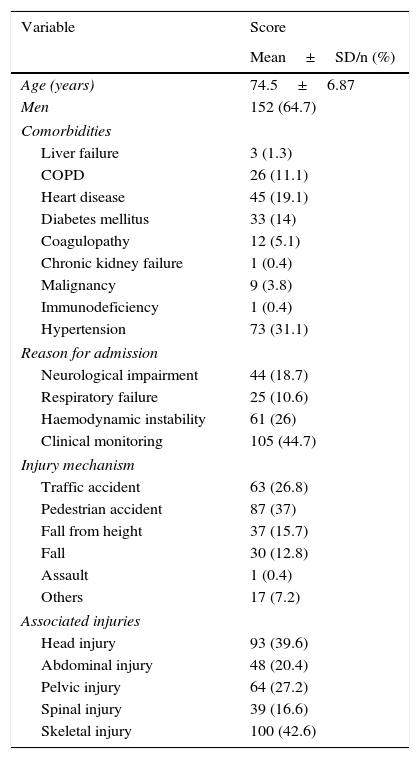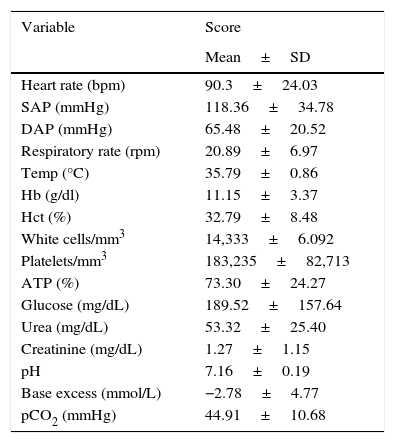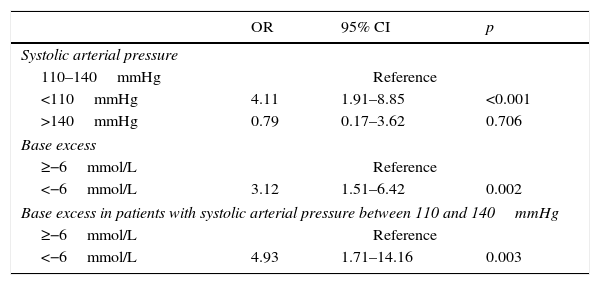To determine the usefulness of the determination of base excess in a cohort of elderly patients admitted to an intensive care unit (ICU) with a diagnosis of chest trauma.
Material and methodTwo hundred and forty-nine patients were included aged 65 years and over with a diagnosis of thoracic trauma who required admission to the ICU. We made a statistical analysis in order to determine the association of the first base excess levels with mortality during the unit stay.
ResultsTwo hundred and forty-nine patients, with a mean APACHE II score of 16.21±7.87 and 24.45±14.16 ISS. Mean ICU stay was 12.74±16.85 days and the mean hospital stay was 26.55±30.1 days. Statistical analysis showed an association with mortality in patients whose blood pressure was lower than 110mmHg on admission, with an OR=4.11 (95% CI 1.91–8.85) compared to patients with blood pressure between 110 and 140mmHg. Those patients who had base excess levels on admission of less than −6mmol/L also showed increased mortality compared to patients with higher levels, with an OR=3.12 (95% CI 1.51–6.42).
ConclusionsThe presence of a base excess level of less than −6 is associated with increased mortality in elderly patients with initial blood pressure between 110 and 140mmHg, diagnosed with thoracic trauma and who require admission to ICU. Routine measurement of this parameter in this population may show the clinical usefulness of assessing possible hidden hypoperfusion.
Precisar la utilidad de la determinación del exceso de bases en una cohorte de enfermos geriátricos que ingresaron en una unidad de cuidados intensivos (UCI) con diagnóstico de traumatismo torácico.
Material y métodoSe incluyeron 249 enfermos con una edad igual o mayor de 65 años y diagnóstico de traumatismo torácico que precisaron ingreso en la UCI. Se realizó un análisis estadístico con el objetivo de determinar la asociación del valor de la primera determinación del exceso de bases con la mortalidad durante la estancia en la unidad.
ResultadosSe analizaron 249 enfermos, con un valor medio de APACHE II de 16,21±7,87 y un ISS de 24,45±14,16. La estancia en UCI fue de 12,74±16,85 días y la estancia hospitalaria media de 26,55±30,1 días. El análisis estadístico mostró una asociación con la mortalidad en aquellos pacientes que presentaron un valor de presión arterial al ingreso inferior a 110mmHg, con una OR de 4,11 (IC 95% 1,91-8,85) respecto a los pacientes con presión arterial entre 110 y 140mmHg. Aquellos pacientes que presentaron un valor de exceso de bases al ingreso inferior a −6mmol/L también mostraron mayor mortalidad respecto a los pacientes con valores mayores, con una OR de 3,12 (IC 95% 1,51-6,42).
ConclusionesLa presencia de un valor de exceso de bases inferior a −6 se asocia con una mayor mortalidad en los pacientes ancianos con cifras iniciales de presión arterial entre 110 y 140mmHg, con diagnóstico de traumatismo torácico y que precisan un ingreso en una UCI. La medición rutinaria de este parámetro en este tipo de población podría mostrar utilidad clínica para la valoración de una posible hipoperfusión oculta.












